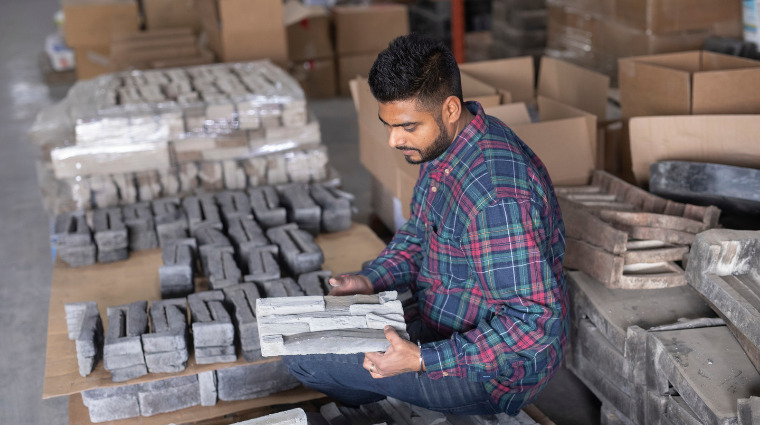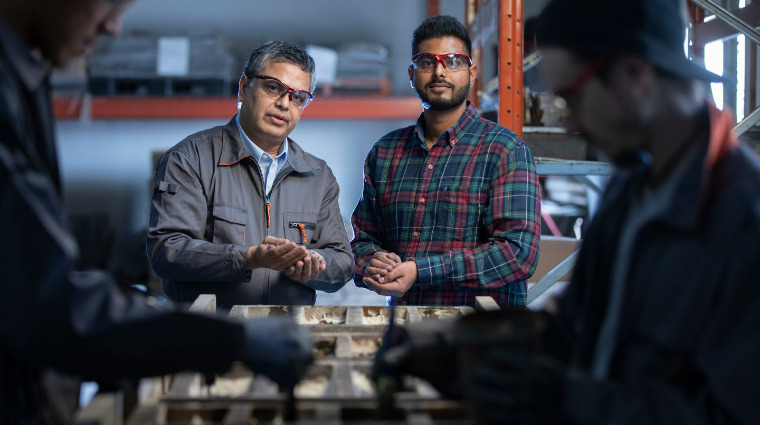Plastics usage, and their ability to be recycled, have come under greater scrutiny in the last few years as governments and organizations have looked to decrease our dependence on plastic. Single-use plastics are being banned in many jurisdictions, and consumers are now looking for reusable, environmentally friendly options for everything from lunch bags to food wrap. As this trend grows, there are also innovators looking for ways to recycle plastics that until now could not go anywhere but the landfill.
Saskatoon entrepreneur Parmjot Maan, president of Innovative Stonecraft, started thinking about how he could improve the veneer building material his company sells. An industrial engineer by trade, he got into manufacturing a few years ago and is always looking at process improvement. After doing some research on his own, a customer mentioned the Applied Research and Innovation office at Saskatchewan Polytechnic. “As it turns out, the Sask Polytech research department is only a couple of blocks from our location,” says Maan. He reached out and began exploring an idea with Dr. Susan Blum, associate vice president, Applied Research and Kevin Rogers, director, Applied Research. They introduced Maan to Dr. Satya Panigrahi, Sask Polytech research chair, Innovative Manufacturing.
Dr. Panigrahi has more than 30 years of experience in plastics and joined Sask Polytech in 2011. He took on the research with Innovative Stonework, thinking about how they could reduce the clay content in the composite veneer to reduce its overall weight by incorporating plastics into its formula. “Introducing non-recycled plastics into the composite would not only reduce weight but would also decrease the costs to produce the veneer and remove plastics from our landfill,” says Panigrahi.
Maan and Dr. Panigrahi began refining ideas on how they could incorporate plastics and fibre into the veneer to create something that is eco-friendly, lightweight, water and crack resistant—and adds R-value to buildings. They developed an idea that would use locally sourced non-recyclable ag plastics waste and crop residues in the concrete mix to manufacture composite stone veneer. This research led to funding for the work from the National Research Council (NRC), the Natural Sciences and Engineering Research Council (NSERC), and Saskatchewan Ministry of Agriculture – Agriculture Development Fund, in addition to the seed funding from Sask Polytech and Innovative Stonecraft.
Today, Dr. Panigrahi and Maan have a prototype that they are refining for market readiness sometime in 2021. “The working relationship I have with Dr. Panigrahi and the Sask Polytech team is invaluable,” says Maan. “I would have never gotten this far without their help and guidance.”
Dr. Panigrahi and the team at Sask Polytech’s Applied Research and Innovation office are always on the lookout for new ideas from industries of all kinds to explore. If you or your organization have an idea that needs some expert advice, don’t hesitate to reach out to learn more. Sask Polytech can connect you with the people that can evaluate your idea, conduct further research, and even source funding for testing and prototypes. “It’s easy to get started,” says Panigrahi. “All it takes is an email to us to begin the process.”
Learn more about applied research at Sask Polytech at saskpolytech.ca/research and Innovative Stonecraft at innovativestonecraft.ca.

This article was originally published in Industry West magazine. Industry West Magazine is a quarterly published business magazine with informative, objective and timely editorial and advertising content for the province’s business community.
Published October 2020.


